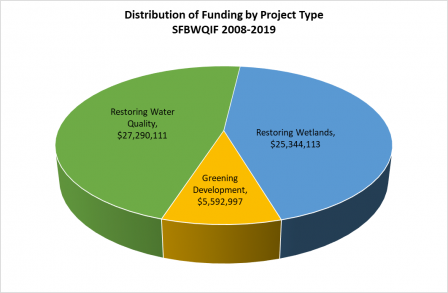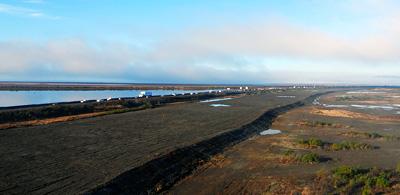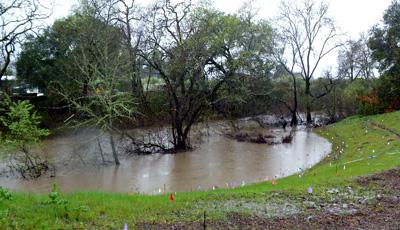SF Bay Water Quality Improvement Fund: Projects
 SFBWQIF 2008-2019 Distribution of Funding by Project Type | Click Image to EnlargeSF Bay Water Quality Improvement Fund (SFBWQIF) projects listed below are part of an EPA competitive grant program to improve SF Bay water quality focused on restoring impaired waters and enhancing aquatic resources. You can see detailed information about SFBWQIF projects in our Interactive Project Map and Progress Reports.
SFBWQIF 2008-2019 Distribution of Funding by Project Type | Click Image to EnlargeSF Bay Water Quality Improvement Fund (SFBWQIF) projects listed below are part of an EPA competitive grant program to improve SF Bay water quality focused on restoring impaired waters and enhancing aquatic resources. You can see detailed information about SFBWQIF projects in our Interactive Project Map and Progress Reports.
Restoring Wetlands

San Francisco Bay is now home to major wetland restoration. Since 1998, over 20,000 acres of wetlands are on their way to being restored. Resource agencies are using the Baylands Ecosystem Habitat Goals Report to guide recovery of an additional 95,000 – 105,000 acres of tidal wetlands. The SFBWQIF has invested over $27 million to restore over 6700 acres of wetlands around the Bay.
Projects
- Breuner Marsh Restoration
- Cullinan Ranch Tidal Marsh Restoration
- Emerson Parcel of Dutch Slough Tidal Marsh Restoration
- India Basin 900 Innes Remediation
- Lower Walnut Creek Restoration Project
- Quartermaster Reach Restoration
- San Francisquito Creek Stabilization at Bonde Weir
- San Pablo Bay Tidal Marsh Enhancement and Water Quality Improvement
- Sears Point Tidal Marsh Restoration: Phase I
- Sears Point Tidal Marsh Restoration: Phase II
- South Bay Salt Ponds: Construction at Mountain View Ponds
- South Bay Salt Pond Mercury Studies
- South Bay Salt Pond Tidal Wetland Restoration Phase II Planning
- South Bay Salt Pond Restoration, Phase II at Ravenswood
- South Bay Salt Pond Tidal Marsh Restoration at Pond A17
- South Bay Salt Pond Restoration Project: Planning Phase at Southern Eden Landing
- Upper York Creek Dam Removal, Fish Passage, and Ecosystem Restoration
Restoring Water Quality

The SFBWQIF has invested over $28 million to address water quality impaired by some of the most challenging pollutants in the Bay, including polychlorinated biphenyls (PCBs), mercury, trash, sediment, and pathogens.
Projects
- Alameda Creek Restoration
- Alameda Creek Restoration - Preparing for the Storm
- Clean Streams in Southern Sonoma County
- Clean Watersheds for a Clean Bay: Implementing the PCB TMDL
- Coyote Creek Trash Reduction Project: Clean Creeks, Healthy Communities
- Estuary 2100, Phase 1: Resilient Watersheds for a Changing Climate
- Estuary 2100, Phase 2: Building Partnerships for Resilient Watershed
- Hayward Youth-Based Trash Capture, Reduction, and Watershed Education Project
- Healthy Watersheds, Resilient Baylands
- Improved Flood Control Channel Design
- Improving Water Quality in Suisun Marsh
- Napa River Restoration: Rutherford Reach Completion and Oakville to Oak Knoll Reach
- Napa River Restoration: Oakville to Oak Knoll Reach, Group A Sites 21-23
- Napa River Restoration: Oakville to Oak Knoll Reach, Group C Site 14
- Napa River Sediment TMDL Implementation and Habitat Enhancement Plan
- Pesticide Reduction Campaign: Greener Pesticides for Cleaner Waterways
- Reducing Nutrients to San Francisco Bay through Additional Wastewater Sidestream Treatment
- Removing Mercury in the Guadalupe River Watershed: Remediating Calcine Paved Roads and Jacques Gulch
- Rethink Disposable: Packaging Waste Source Reduction Pilot
Greening Urban Development: Reducing Polluted Runoff

There is growing recognition that green development practices, such as low impact development (LID), using natural hydrologic processes to treat polluted runoff, should become common practice. To encourage widespread adoption of LID stormwater treatments, the SFBWQIF awarded over $7 million to local governments to implement nine projects throughout the Bay Area. Projects range from small one-block pilots to large-scale multi-block efforts. The projects also assist communities to develop policies and technical expertise necessary to continue to support and encourage green development practices.
